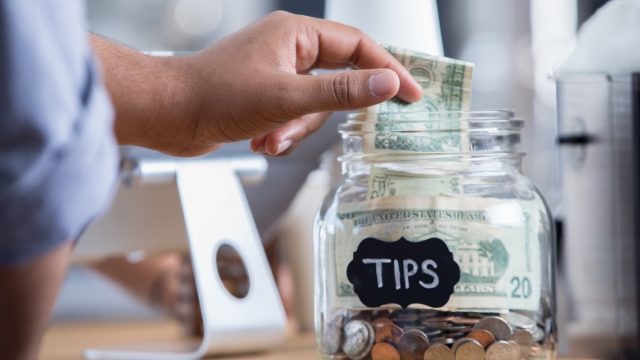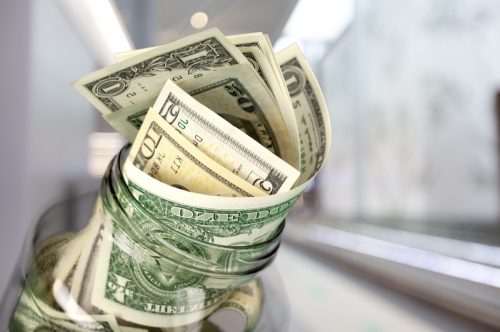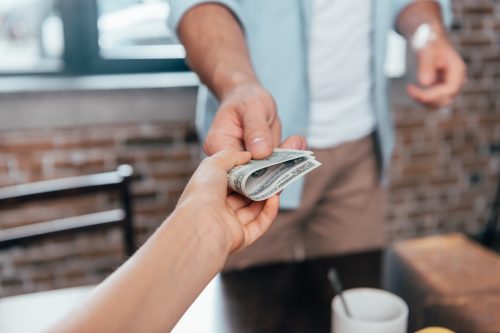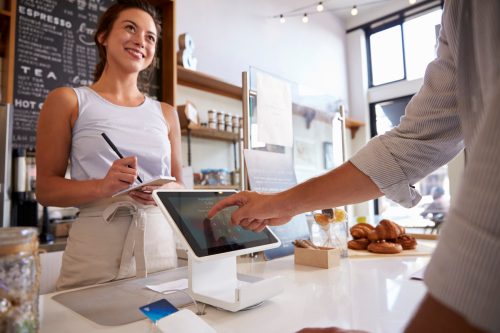These Are the Worst Tippers in the U.S., New Data Shows

Tipping has often been a hot-button issue, but never more so than right now. We’ve become inundated with requests to add 20, 25, or even 30 percent gratuity on top of all manner of purchases. Tipping is no longer just reserved for servers at sit-down restaurants or busy bartenders. Now, screens prompt us to tip for to-go orders and self-checkout at major retailers. But while some people may have no problem going with the flow of an evolving tipping culture, others have made it clear they’re not shelling out for extra gratuity. Read on to discover the worst tippers in the U.S., based on new data.
READ THIS NEXT: New Law Wants to Introduce Tipping at Walmart and Other Major Retailers.
In a new survey, more than half of respondents said they feel negative about tipping.

A new survey from Bankrate has determined that there is one thing we agree on about tipping: We’re not really a fan. According to the survey, which was conducted at the beginning of May, 66 percent of U.S. adults have a negative view on tipping.
“Few topics elicit as many passionate opinions as tipping,” Ted Rossman, a Bankrate senior industry analyst, said in a statement. “There’s so much confusion regarding who to tip, and if so, how much. A lot is changing, as technology makes it easier to tip some people and harder to tip others—as travelers who are short on cash can attest.”
But people are still doing it—for the most part.

These negative feelings toward tipping haven’t stopped most of us from doing it—though a lot comes down to the type of service. Bankrate found that 65 percent of U.S. adults who eat at sit-down restaurants are always tipping their waiters, “making it the service that Americans are most likely to always tip,” the researchers explained.
Food delivery services are also seeing a decent amount of tipping, with 50 percent of those who order meals or groceries from apps like Uber Eats and DoorDash reporting that they always tip.
Following servers and waitstaff at sit-down restaurants, hair stylists are the second most likely group of service workers to receive gratuity—as 53 percent of U.S. adults said they always tip their hairdressers, hair stylists, or barbers, according to the survey.
Home repair workers, on the other hand, see tips less often than anyone els. “[Only] 10 percent of U.S. adults who have home services or repair people always tip the workers, making it the service that Americans are least likely to always tip,” the researchers stated.
RELATED: For more up-to-date information, sign up for our daily newsletter.
Certain age groups are less likely to tip than others.

It’s not just the type of service that determines who gets tipped and who doesn’t. Bankrate found that it also comes down to who is being asked to tip.
According to the survey, Gen Zs are considered the worst tippers in the U.S. Within this age group—which includes people 18 to 26 years old—only 35 percent always tip when they eat at a sit-down restaurant, 31 percent always tip when they get food delivery, 24 percent always tip their hair stylists, and 22 percent always tip for taxis or ride shares.
Meanwhile, baby boomers are the most likely to tip. “The tendency to tip increases with age,” the researchers wrote.
Compared to Gen Z, 70 percent of people ages 59 to 77 always tip when they go to a hairdresser, while 83 percent always tip at sit-down restaurants, 62 percent always tip when they get food delivery, and 56 always tip for taxis or ride shares in the baby boomer group.
Women are also more likely to tip than men.

There’s also a clear difference for gratuity when it comes to gender. “Generally, men are less likely to always tip than women are,” according to Bankrate.
The most significant divide between these two groups can be seen with hair services. The survey found that 60 percent of women who see a hair stylist always tip, while only 46 percent of men do so.
But men tip waiters, food delivery workers, and other service employees less frequently than women do as well.
According to the survey, 60 percent of men always tip their servers at sit-down restaurants compared to 70 percent of women who do the same. In terms of food delivery workers, 54 percent of women always give them gratuity, while 45 percent of men do so. And when using taxis or ride shares, the breakdown between those who always tip is 45 percent of women and 36 percent of men.